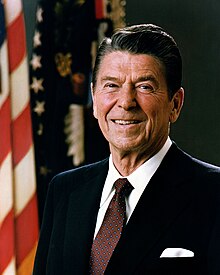Reagan Doctrine
The Reagan Doctrine was a US strategy during the Cold War that aimed to weaken and ultimately overthrow the governments of pro-Soviet states (or, in general, Marxist-influenced governments) through the support of anti-communist guerrilla organizations . In parts a counterpart to the Brezhnev Doctrine and as a variant of the rollback proclaimed in the 1950s , it formed a core element of American foreign policy during the 1980s.
Origin and effect
The American President Ronald Reagan introduced the doctrine named after him to the public in his State-of-the-Union address of February 1985. The key phrase was:
“We must stand by all our democratic allies. And we must not break faith with those who are risking their lives — on every continent, from Afghanistan to Nicaragua — to defy Soviet-supported aggression and secure rights which have been ours from birth. ”
“We must stand by all of our democratic allies. And we must not lose the trust of those who risk their lives - on every continent, from Afghanistan to Nicaragua - to counter Soviet aggression and secure the rights that we have from birth. "
The Reagan Doctrine found strong support in the national conservative Heritage Foundation , which it formulated and developed itself. The original English name Reagan Doctrine comes from an article by columnist Charles Krauthammer that appeared in Time magazine.
The Reagan Doctrine led to financial and military technical support for the Contras in Nicaragua, the Mujahideen in Afghanistan and the UNITA of Jonas Savimbi in Angola, as well as other anti-communist rebel groups . The advantage of these indirect interventions was the relatively small amount of time, money and labor that the USA had, while the USSR itself had to go to great lengths to support allied states. In addition, the US could avoid becoming involved in acts of war itself. On the other hand, the legality of destabilizing actions against governments recognized under international law was problematic, which often made official funding impossible and brought about breaches of the law (see e.g. Iran-Contra affair ) .
The doctrine sparked intense public debate and was one of the most discussed political issues from the mid-1980s; the concept as such is still controversial today. In defense of the Reagan Doctrine, proponents such as Margaret Thatcher cite the 1990 election in Nicaragua and the withdrawal of the Soviet army from Afghanistan, which the left Sandinista lost after the guerrilla war. Factors that should ultimately have contributed to the dissolution of the Soviet Union. Critics of the doctrine point to the intensification of third world conflicts through proxy wars and to uncontrollable consequences ( blowback ) of secret service operations and the support of militant resistance groups. In particular, terrorist Islamism has its roots in the clandestine Afghanistan policy of the 1980s.
See also
literature
- Thomas Meier: The Reagan Doctrine. The images of the enemy, the images of friends. Afghanistan, Angola, Cambodia, Nicaragua. Lang, Bern 1998, ISBN 3-906759-68-7 (also: Zurich, Univ., Diss., 1996/97).
- Heiko Meiertöns: The Doctrines of American Security Policy. Evaluation of international law and its influence on international law (= international law and foreign policy. Vol. 71). Nomos, Baden-Baden 2006, ISBN 3-8329-1904-X (also: Munich, Univ., Diss., 2005).
Web links
- "The Contras, Cocaine, and Covert Operations," Guerrilla Support Documents Published in the National Security Archive, George Washington University, August 1996. (English)
Individual evidence
- ↑ Complete text .
- ↑ Quotation with explanatory information from the US State Department website ( Memento of May 2, 2006 in the Internet Archive ) (via Internet Archive ).
- ^ Charles Krauthammer: The Reagan Doctrine. In: Time . June 24, 2001 (republication of the April 1, 1985 article). The term has been used before, albeit in a different context, as in Isaac Asimov : The Reagan Doctrine , in: The Austin American-Statesman , May 10, 1981 .
